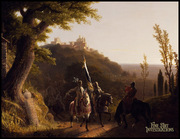
Oil on Canvas 24 x 20 inches
Los Angeles County Museum of Art M.72.104.1
Fine Art Investigations researches more than portraits. One in-depth research project involved the artistry of Robert Walter Weir (1803-1889), who taught drawing at West Point for 42 years. Drawing was then a necessary skill for military officers, not only for creating maps or preserving exploratory discoveries in the age before cameras, but because a trained eye could make better field decisions. Influential in Weir’s appointment to the military academy, was his friend Gulian Crommelin Verplanck (1786-1870), a descendant of New York’s early Dutch settlers, a history teacher at the National Academy of Design, a politician, and author.

Oil on Panel, 28.5 x 33 inches
Metropolitan Museum of Art, 2000.161
www.metmuseum.org
Both men were members of the Sketch Club, a friendly group of writers and artists that included William Cullen Bryant (1794-1878), Thomas Cole (1801-1848), Asher Brown Durand (1796-1886), Henry Inman (1801-1846) , and Samuel F. B. Morse (1791-1872). The goal of the club could be said to inspire one another, most famously through Durand’s painting, Kindred Spirits, 1849, depicting Cole and Bryant in the natural beauty of Kaaterskill Clove in the Catskills. But 15 years earlier, Weir and Verplanck inspired one another with a painting and a play.
On October 11, 1834, in the New-York Mirror, Verplanck wrote, “My friend Weir was at work upon a very pleasing landscape…It occurred to me that the picture would gain much additional interest by the addition of some historical figures, or a story connected with the scene.”

Weir added historical figures to his landscape study of light and shadow. Its lengthy title, The Duke of Bourbon’s Halt at La Riccia on His March to the Assau Rome May 3d, 1527 fit the play Verplanck published in the New-York Mirror, and which was later included in a Gift Book.



Three years after the initial collaborative effort, Verplanck was influential in Weir’s commission to create one of four historic paintings for the rotunda of the nation’s capitol. On Christmas Day, 1837, Weir’s fifth child was born and later christened Gulian Verplank Weir. The painting that grew from the mutual inspiration of the artist and the politician was Weir’s most famous work, Embarkation of the Pilgrims, 1843.

Oil on Canvas, 12 x 18 feet
United States Capitol Rotunda.jpg

